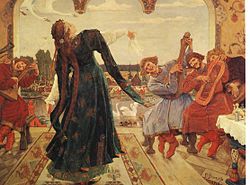The Frog Princess

The Frog Princess is a fairy tale that has multiple versions with various origins.
Russian variants include the Frog Princess or Tsarevna Frog (Царевна Лягушка, Tsarevna Lyagushka) and also Vasilisa the Wise (Василиса Премудрая, Vasilisa Premudraya); Alexander Afanasyev collected variants in his Narodnye russkie skazki. Andrew Lang included an Italian variant titled The Frog in The Violet Fairy Book.[1] Italo Calvino included another Italian variant from Piedmont, The Prince Who Married a Frog, in Italian Folktales,[2] where he noted that the tale was common throughout Europe.[3] Georgios A. Megas included a Greek variant, The Enchanted Lake, in Folktales of Greece.[4]
It is classified as type 402, the animal bride, in the Aarne-Thompson index.[5] Another tale of this type is Doll i' the Grass.[6]
Synopsis
The king (or an old peasant woman, in Lang's version) wants his three sons to marry. To accomplish this, he creates a test to help them find brides. The king tells each prince to shoot an arrow. According to the King's rules, each prince will find his bride where the arrow lands. The youngest son's arrow is picked up by a frog. The king assigns his three prospective daughters-in-law various tasks, such as spinning cloth and baking bread. In every task, the frog far outperforms the two other lazy brides-to-be. In some versions, the frog uses magic to accomplish the tasks, and though the other brides attempt to emulate the frog, they cannot perform the magic. Still, the young prince is ashamed of his frog bride until she is magically transformed into a human princess.
In Calvino's version, the princes use slings rather than bows and arrows. In the Greek version, the princes set out to find their brides one by one; the older two are already married by the time the youngest prince starts his quest. Another variation involves the sons chopping down trees and heading in the direction pointed by them in order to find their brides.[7]

In the Russian versions of the story, Prince Ivan and his two older brothers shoot arrows in different directions to find brides. The other brothers' arrows land in the houses of the daughters of an aristocratic and wealthy merchant. Ivan's arrow lands in the mouth of a frog in a swamp, who turns into a princess at night. The Frog Princess, named Vasilisa the Wise, is a beautiful, intelligent, friendly, skilled girl who was forced to spend 3 years in a frog's skin for disobeying Koschei. Her final test may be to dance at the king's banquet. The Frog Princess sheds her skin, and the prince then burns it, to her dismay. Had the prince been patient, the Frog Princess would have been freed but instead he loses her. He then sets out to find her again and meets with Baba Yaga, whom he impresses with his spirit, asking why she has not offered him hospitality. She tells him that Koschei is holding his bride captive and explains how to find the magic needle needed to rescue his bride. In another version, the prince's bride flies into Baba Yaga's hut as a bird. The prince catches her, she turns into a lizard, and he cannot hold on. Baba Yaga rebukes him and sends him to her sister, where he fails again. However, when he is sent to the third sister, he catches her and no transformations can break her free again.
In some versions of the story, the Frog Princess' transformation is a reward for her good nature. In one version, she is transformed by witches for their amusement. In yet another version, she is revealed to have been an enchanted princess all along.
Variants
This tale is closely related to Puddocky and its variants, in which a king sets three tasks to his sons to determine which is best suited to rule the country, and a transformed frog helps the youngest prince.
Adaptations
- Vasilisa the Beautiful, a 1939 Soviet film directed by Aleksandr Rou is based on this plot. It was the first large-budget feature in the Soviet Union to use fantasy elements, as opposed to the realistic style long favored politically.[8]
- In 1953 the idea to picturize this popular national fairy tale came to the director Mikhail Tsekhanovsky. Production took two years, the premiere took place in December, 1954. In present time the animated film is included in gold classics of "Soyuzmultfilm". In 1960 it won the prize "Silver Oak Leaf" on the IFF in Mar del Plata (Argentina).
- Vasilisa the Beautiful, a 1977 Soviet animated film is also based on this fairy tale.
- Taking inspiration from the Russian story, Vasilisa appears to assist Hellboy against Koschei in the 2007 comic book Hellboy: Darkness Calls.
- The Frog Princess was featured in Happy Ever After: Fairy Tales for Every Children, where it was depicted in a country setting. The episode features the voice talents of Jasmine Guy as Frog Princess Lylah, Greg Kinnear as Prince Gavin, Wallace Langham as Prince Bobby, Mary Gross as Elise, and Beau Bridges as King Big Daddy.
See also
References
- ^ Andrew Lang, The Violet Fairy Book, "The Frog"
- ^ Italo Calvino, Italian Folktales p 438 ISBN 0-15-645489-0
- ^ Italo Calvino, Italian Folktales p 718 ISBN 0-15-645489-0
- ^ Georgias A. Megas, Folktales of Greece, p 49, University of Chicago Press, Chicago and London, 1970
- ^ Georgias A. Megas, Folktales of Greece, p 224, University of Chicago Press, Chicago and London, 1970
- ^ D. L. Ashliman, "Animal Brides: folktales of Aarne-Thompson type 402 and related stories"
- ^ Out of the Everywhere: New Tales for Canada, Jan Andrews
- ^ James Graham, Baba Yaga in Film
